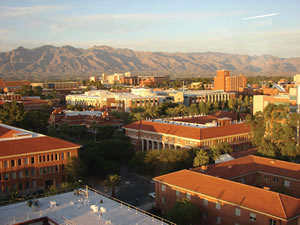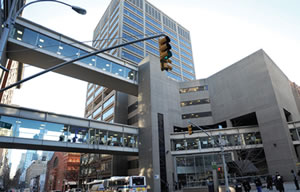Roofs That Last

PHOTO COURTESY OF HUPERPHUFF
With all that a roof does for a structure, you can’t just build it and forget it. Proper maintenance is key to keeping your campus roofs in good working order and getting the best return on investment for your school. Three schools, in three very different climates, talk about their roofing program and how they stay on top of the situation.
University of Arizona, Tucson
The roofs at University of Arizona in Tucson are tough. They need to be to hold up under extreme temperatures — 117ºF, anyone? — and a monsoon season that regularly delivers an inch and a half of rain during a half-hour downpour. Yet, like many schools under budgetary pressure, the University of Arizona is balancing the need to care for their roofs with a 10-year deferred maintenance plan. What does that mean for the some 11 million square feet of buildings, a hefty percentage of which are 50 to 70 years old, on campus?
“We have to prioritize replacement 10 years out,” says Chris Kopach, assistant vice president for facilities management. To keep existing roofs in good order and stretch their life, the university has a four-person crew dedicated solely to inspection and preventative maintenance.
This dedicated crew provides boots on the roof four times a year. They rigorously look for and document pooling water, cracks in the surface or any other irregularity. They apply a white elastomeric coating every four years… sooner, if deemed necessary to stretch the life of the roof. It’s hard work. “It takes a unique individual to get up on a roof in 115º weather,” says Kopach. “But these guys do it with pride.”
To keep track of all of the moving parts, the crew uses a computerized maintenance program. It catalogs every roof on campus, noting the building’s age, its last roof replacement and last preventative maintenance.
The school always has an eye out for new technologies that will help stretch the life of the roof. “There are a lot of coating options out there and prices can run from $10 a gallon to $60,” says Thomas Webb, senior project manager. He also notes that warranties on some of these products claim a 50-year life. He is currently subjecting eight different experimental products to Arizona’s uniquely harsh conditions on the roof of the school’s basketball stadium.
What did he find?
“Some things are good and some are not,” he enigmatically reports.
Weber State University, Ogden, UT
With a climate full of snow, ice and high winds, the roofs of the 115 buildings at Weber State University suffer through unique environmental pressure. Gil Green, project manager, reports that there are two different groups that regularly inspect the surfaces.
“The preventative maintenance group inspects annually, and the structural group will check for leaks as needed from the inside with an infrared gun.” Green admits the he would prefer visual rooftop inspection four times a year rather than the annual schedule. He states that larger roofs, or ones with lots of penetrations like solar panels, stick to that quarterly inspection regime.
Weber has a variety of roof types on campus. Private homes that the school has purchased employ typical asphalt shingles. The rest have flat roofs. Green states that, after an incident in 2012 when high wind blew gravel off of one built-up roof and into the window of another, the school is moving away from ballast, built-up products.
No matter the roof type, the school remains very protective of their warranties and will go to great lengths to sidestep voiding them. “If we pinpoint a leak we call the roofing contractor that holds the warranty to fix it,” states Green. He also employs the contractor any time his group needs to create a penetration during a construction project. “We post the name of the firm that holds the warranty on the entrance to every roof,” he says. “There are several in the area.”
Hunter College, New York, NY
James A. Gleba, assistant vice president for facilities management and planning, does not have a dedicated roofing staff to care for the some 2.7 million square feet of buildings that make up Hunter College’s urban campus. However, someone is up on the roofs at least once a month. “With all of the equipment we have up there, HVAC systems, cell phone equipment, blowers and the like, there is a lot of traffic on the roofs,” he says.

PHOTO COURTESY OF HUNTER COLLEGE
GOOD ROOFS MAKE GOOD NEIGHBORS. If problems are going to occur on flat roofs, they usually occur around the drains, pitch boxes, flashing and electrical piping. Regular inspections, maintenance and oversight can prevent massive and costly roof problems from occurring. When those roofs are on the facilities of a college rooted in an urban setting — such as Hunter College in New York City — staying ahead of potential problems is vital because repairs and replacement are disruptive. Simply coordinating materials deliveries is itself a challenge, as nearby residents and businesses must be kept in the loop in order to minimize interruptions and remain good neighbors.
No matter why a maintenance person is on top of a building, part of the job is visually inspecting the roof. The worker looks for proper drainage, unwanted debris, stable penetrations and well-maintained lighting. The procedure has two benefits. The first is to maintain the life of a roof that suffers through the east coast’s grueling freeze and thaw cycles. The second is specific to the school’s uniquely urban New York City location.
“The tops of our buildings are viewed by many people and we want to be good neighbors,” Gleba says of his Upper East Side surrounds. That means keeping the roofs clear and clean-looking and making sure that lighting doesn’t trespass into neighboring apartments. “We want to make sure nothing interferes with their quality of life.”
Gleba will undoubtedly make life a bit inconvenient for his neighbors in the coming months. Hunter is about to embark on two big roof replacement projects. The first is on a 700,000-square-foot building made up with 15 individual roofs. “It will take us 12 to 15 months to complete,” he says of the $4-4.5 million project.
Gleba admits that replacing the over-30-year-old roof will be “very disruptive.” While most schools do this kind of work during the summer months, Gleba cannot, as the large crane required would interrupt street fairs and other warm-weather activities. Instead, he will carefully coordinate material delivery (“In Manhattan you can’t just have materials delivered whenever you want,” he explains.) and conduct extensive community outreach to let his neighbors know the schedule.
To get the best ROI on the project, Gleba will ensure that the chosen contractor is well qualified to work in an urban environment and that the manufacturer certifies the workers. “The manufacturer’s rep will be here to oversee all of the work,” he says. “I want this roof to last another 30 years.”
This article originally appeared in the issue of .